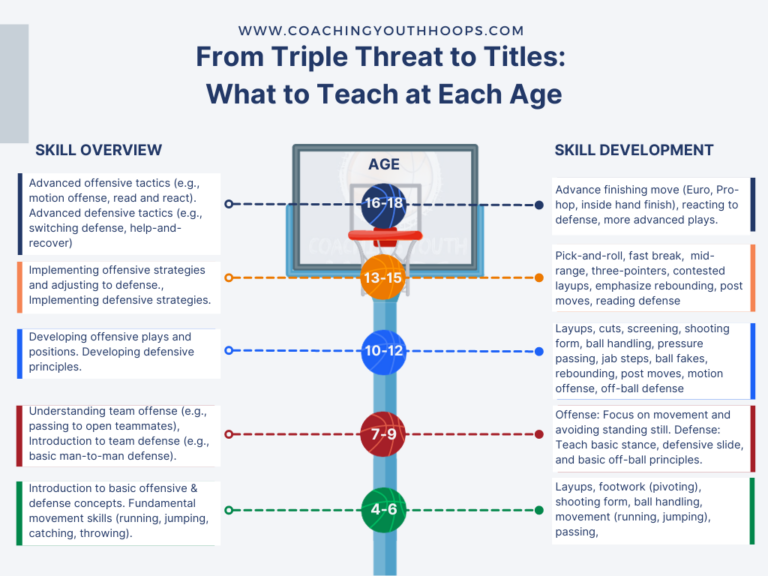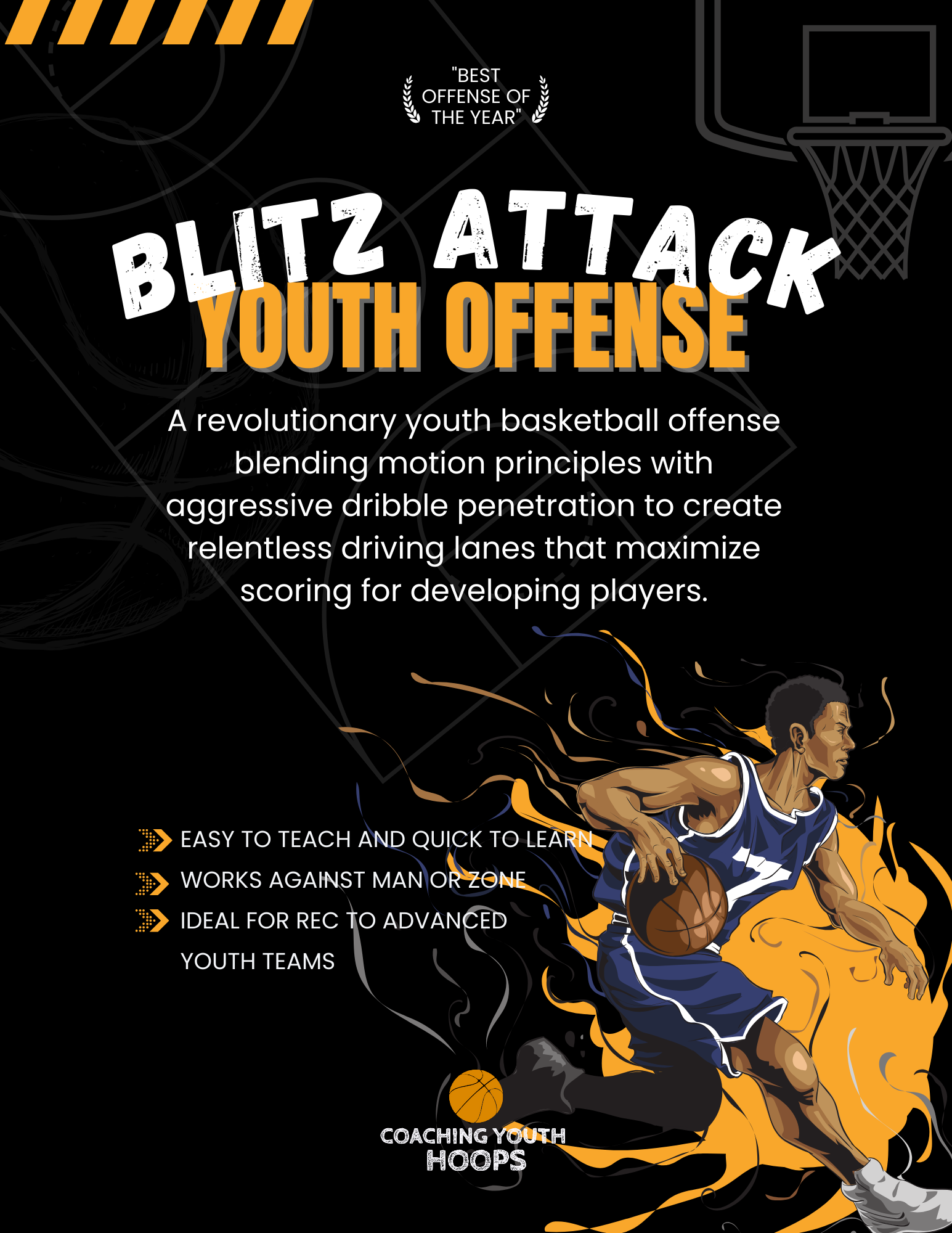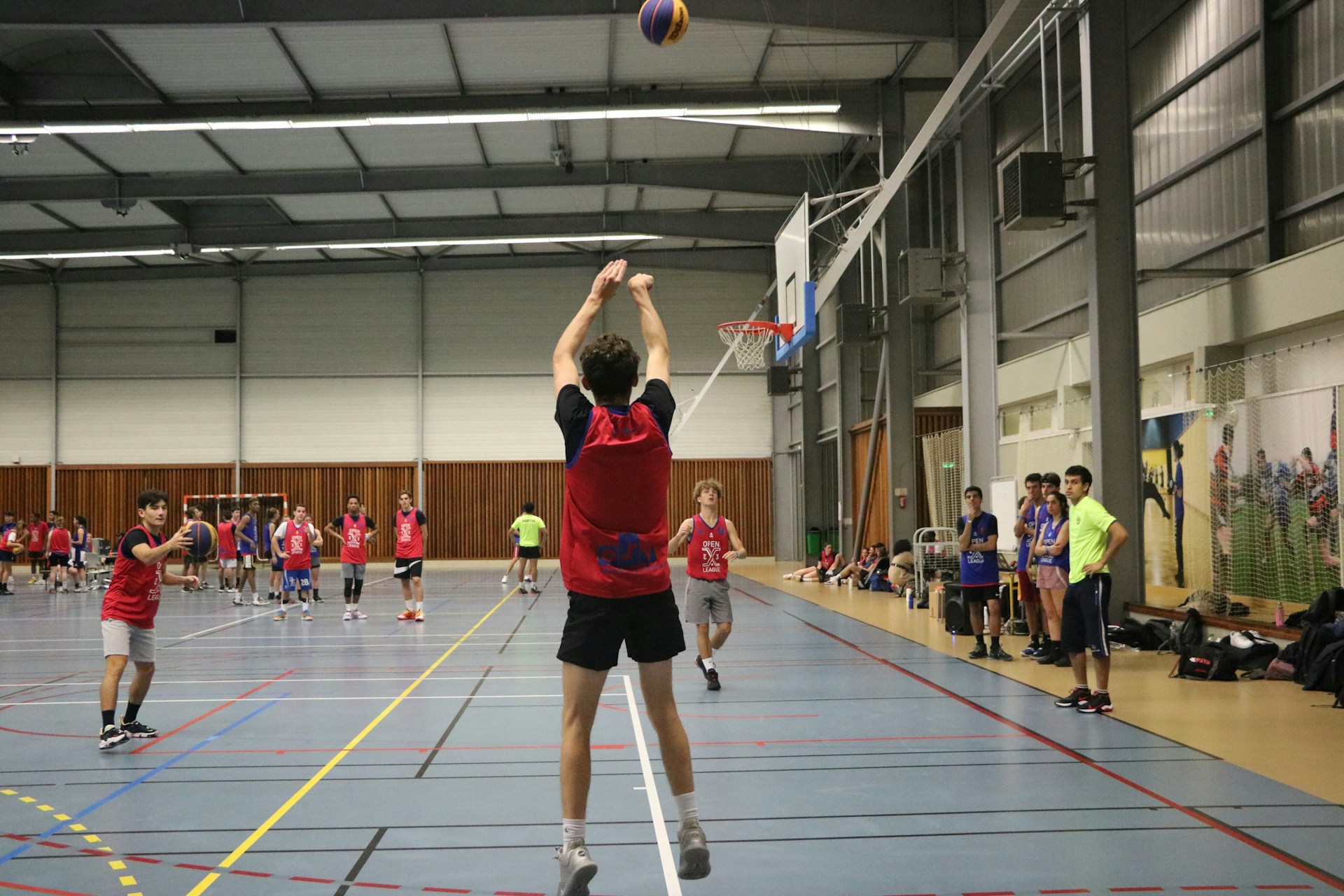Discussion Points:
- Introduction
- The Importance of Teaching Fundamentals to Young Players
- Key Benefits to Focusing on the Fundamentals
- 12 Basketball Fundamentals to Focus On
- Conclusion
- FAQs
12 Basketball Fundamentals to Focus on in Youth Basketball
As a veteran basketball coach with over 20 years of experience, I’ve seen firsthand the transformative power of focusing on the fundamentals. When coaching youth basketball, it’s crucial to lay a strong foundation by emphasizing the basics. This approach not only improves individual skills but also enhances team performance, making the game more enjoyable for everyone involved. Young athletes who master the basics gain confidence, develop better game awareness, and build a solid platform for more advanced techniques.
In this post, I’ll share why teaching basketball fundamentals is so important, provide detailed recommendations for practice, and answer common questions from inexperienced coaches and parents. By prioritizing the fundamentals, you will not only help your players become better athletes but also instill in them a love for the game that will last a lifetime. The fundamentals are the key to unlocking a player’s potential, and by making them the core of your coaching philosophy, you’ll set your team up for long-term success. Let’s dive into the critical aspects of teaching basketball fundamentals to young players and how you can effectively incorporate them into your coaching routine.
The Importance of Teaching Fundamentals to Young Players
The fundamentals of basketball are the building blocks of every play, strategy, and move on the court. The best players in the world have perfected these basics, making the rest of the game come naturally to them. By focusing on basketball fundamentals, young players develop the skills they need to succeed, both individually and as part of a team. This foundational knowledge makes learning advanced techniques and strategies much easier and more effective.
4 Key Benefits of Focusing on Basketball Fundamentals:
- Improved Skill Development: Mastery of basic basketball fundamentals like dribbling, shooting, and passing allows players to execute more complex maneuvers with ease. When young players can dribble without looking at the ball, pass accurately under pressure, and shoot with proper form, they are well equipped to handle various game situations. This skill development not only makes them better players but also boosts their confidence and enjoyment of the game.
- Better Team Play: Understanding and executing team strategies such as setting screens and reading defenses are essential for cohesive team performance. Players who grasp the fundamentals can work together more effectively, setting solid screens, making smart cuts, and understanding defensive rotations. This leads to better ball movement, more scoring opportunities, and stronger defensive play.
- Increased Confidence: Players feel more competent and enjoy the game more when they have a solid grasp of the basics. Confidence on the court comes from knowing that you can perform essential skills reliably. When young players are confident in their abilities, they are more likely to take initiative, make smart decisions, and recover quickly from mistakes.
- Long-term Success: Strong basketball fundamentals provide a solid base for future growth and advanced play. As players progress to higher levels of competition, the fundamentals remain critical. A solid foundation allows for smoother transitions to advanced techniques and strategies, enabling players to adapt to different coaches, teams, and styles of play.
What to Teach at Each Age
Unlock the secret to crafting drills and practice plans that perfectly match your team’s cognitive and motor skill growth at every age level.

12 Basketball Fundamentals to Focus On
To ensure your players develop strong basketball fundamentals, spend the majority of each practice focusing on these areas. Here are some essential skills and techniques to prioritize:
1. Layups
- Technique: Teach proper footwork, ball placement, and finishing at the rim. Emphasize using the correct hand for each side of the basket and maintaining balance and control while driving to the hoop.
- Drills: Use drills that emphasize repetition and finishing through contact. For example, the “Mikan Drill” helps players practice layups from both sides of the basket. Incorporate drills where players must finish layups after receiving contact or while under defensive pressure to simulate game conditions.
2. Shooting
- Technique: Focus on foot alignment, leg bend, hand position, arm angle, and follow-through. Proper shooting form is crucial for consistency and accuracy.
- Drills: Practice spot shooting, free throws, and shooting off the dribble. Use timed drills like “4-Minute Shooting” for spot shooting under pressure, “Free Throw Line Game” for free throws under pressure, and “Pull-up Shooting” for shooting off the dribble. Emphasize the importance of a consistent shooting routine and practice it regularly.
3. Free Throw Shooting
- Technique: Develop a consistent routine, proper stance, and follow-through. Ensure players focus on their form and mental approach to free throws.
- Drills: Simulate game pressure situations to improve focus and consistency. For example, have players shoot free throws at the end of practice when they are tired or during scrimmages where missed free throws can impact the outcome.
4. Passing
- Technique: Teach the use of chest passes, bounce passes, and overhead passes. Emphasize accuracy, speed, and the ability to pass under pressure.
- Drills: Incorporate passing drills that require quick decision-making and accuracy. Use “Partner Passing” for basic technique, “Keep Away” to practice passing under pressure, and “No-Dribble Scrimmage” to develop passing.
5. Dribbling and Ball Handling
- Technique: Emphasize control, change of pace, and protecting the ball. Teach players to dribble with their heads up and use both hands effectively.
- Drills: Use cone drills, figure-eight dribbling, and pressure situations to improve ballhandling skills. “Cone Dribbling” helps with control and agility, “Figure Eight” enhances hand coordination, and “Pressure Dribbling” simulates defensive pressure.
6. Jump Stops
- Technique: Teach proper footwork to come to a complete stop without traveling. Emphasize balance and control when stopping.
- Drills: Practice in transition and half-court settings to reinforce muscle memory. Use drills like “Jump Stop and Pivot” where players must stop and pivot under defensive pressure, and “Transition Jump Stops” to practice stopping quickly after sprinting.
7. Triple Threat Position and Pivoting
- Technique: Proper stance, ball protection, and pivot footwork are essential. Teach players to be ready to pass, dribble, or shoot from this position.
- Drills: Include drills that simulate game scenarios where players need to pivot to avoid defenders. Use “Triple Threat Drill” to practice reading the defense and making decisions and “Pivot and Pass” to emphasize quick pivots and accurate passing.
8. Jab Steps
- Technique: Quick, decisive movements to create space and keep defenders off balance. Emphasize the importance of selling the fake and maintaining balance.
- Drills: Use one-on-one drills to practice jab steps and follow-up moves. For example, “Jab and Go” where players use a jab step to drive past a defender, and “Jab Step Series” to practice different jab step combinations.
9. Basic Screening and Cutting
- Technique: Setting screens shoulder to shoulder, reading defenses, and cutting to the basket effectively. Teach players to use and set screens properly to create scoring opportunities.
- Drills: Incorporate plays that emphasize proper screening and cutting techniques. Use “Screen and Roll” drills to practice setting screens and rolling to the basket, and “Down Screen” drills to work on setting and using off-ball screens.
10. Defense
- Technique: Stance, footwork, and positioning to see both the ball and the opponent. Teach players to stay low, move their feet, and maintain balance.
- Drills: Use defensive slides, closeouts, and one-on-one drills to enhance defensive skills. “Defensive Slide Drill” improves lateral movement, “Closeout Drill” focuses on closing out on shooters, and “1-on-1 Defense” develops individual defensive ability.
11. Rebounding
- Technique: Boxing out, timing, and aggressive pursuit of the ball. Teach players to anticipate shots and position themselves for rebounds.
- Drills: Simulate game-like rebounding situations to improve instincts and toughness. Use “Box Out Drill” to practice boxing out opponents, “Rebounding Battles” to compete for rebounds under pressure, and “Rebound and Outlet” to practice securing the rebound and starting the fast break.
12. Basic Post Moves
- Technique: Footwork, positioning, and finishing moves in the paint. Teach players to use their body effectively to create scoring opportunities.
- Drills: Practice post drills that focus on moves such as drop steps, jump hooks, and up-and-under moves. Use “Drop Step Drill” to work on basic post moves, “Hook Shot Drill” for developing a reliable hook shot, and “Up-and-Under Drill” to practice fakes and finishing.
Conclusion
Focusing on basketball fundamentals is the key to developing successful and confident basketball players. By prioritizing these essential skills, you’ll not only improve your team’s performance but also foster a love for the game that will last a lifetime. Consistent practice of the basics builds muscle memory and instills good habits that will serve players well in every aspect of the game.
Remember, no matter the age or experience level, strong fundamentals are the foundation of success in basketball. Emphasize the basics in every practice, and watch your players grow into skilled and confident athletes. As they master these fundamental skills, they will be better prepared to tackle more advanced concepts and strategies, leading to greater overall team success. Your commitment to teaching the basic basketball fundamentals will set your players on the path to becoming not only better athletes but also more disciplined and dedicated individuals.
Zoom Action Continuity Youth Offense
I developed the Blitz Attack to maximize scoring for developing players. This innovative continuity offense blends the best of Zoom Action and motion principles with aggressive dribble penetration.

FAQs
Q: Why are fundamentals so important in youth basketball?
A: Basketball fundamentals are the building blocks of every play and strategy. They help young players develop essential skills, improve their understanding of the game, and build confidence.
Q: How much practice time should be devoted to basketball fundamentals?
A: Spend the majority of each practice on fundamentals. This ensures that players develop a strong foundation before moving on to more complex strategies.
Q: What are some key fundamentals to focus on?
A: Key basketball fundamentals include layups, shooting, foul shooting, passing, dribbling, jump stops, triple threat position, jab steps, basic screening and cutting, defense, rebounding, and basic post moves.
Q: How can I make practicing basketball fundamentals engaging for young players?
A: Use a variety of drills that simulate game situations, incorporate competition, and provide positive feedback. Keep the energy high and ensure that players see their improvement over time.
Q: When should I start teaching advanced strategies like full-court press?
A: Only introduce advanced strategies once your players have mastered the basketball fundamentals. This ensures they have the necessary skills and understanding to execute more complex plays effectively.



